Origin and History
The Red Boston Terrier is a variation of the Boston Terrier breed, which was created in 1865 by crossbreeding an English Bulldog with an English Terrier. The breed originated around 1875 when Robert C. Hooper of Boston purchased a dog named Judge from Edward Burnett. Judge was believed to be a cross between an English Bulldog and a White English Terrier, a breed that is today extinct. The red fur-coloring of the Red Boston Terrier is considered non-standard for its breed and is due to a gene mutation that has been propagated throughout the breed’s history.
Hypoallergenic Qualities
Boston Terriers, including the Red Boston Terrier, are not considered hypoallergenic dogs. They shed very lightly and have short hair, but they produce a large amount of dander that can trigger allergies. People with mild allergy symptoms may be able to keep a Boston Terrier with regular cleaning and grooming. Still, people with severe allergies should think long and hard about this decision.
Coat Variety
Red Boston Terriers have a unique red coat color that ranges from light copper or brown to a rich, deep red. The coat also doesn’t include pigmentation or black hairs. White markings are present in the chest, between the eyes, and around the muzzle. The red coat of this canine resembles a liver-toned hue.
Size Range
Red Boston Terriers are compactly-built, standing 15 to 17 inches in height, and weighing 12 to 25 pounds. They belong to a family of brachycephalic dogs, which are breeds with shortened snouts.
Temperament
True to its name, The American Gentleman, the Red Boston Terrier is a well-mannered dog with a cool temperament. Like other Boston Terriers, it’s also affectionate, smart, and a people-oriented dog. This cute little dog is also perfect for small apartment dwellers because it only barks when necessary.
Exercise Needs
As a general rule, most Boston Terriers, including the Red Boston Terrier, require 30-60 minutes of exercise per day. This can include activities like brisk walks, playtime in a fenced yard, or indoor games, such as fetch or tug-of-war.
Health Considerations
Red Boston Terriers are prone to several health issues. Some of the common health issues are Brachycephalic Airway Syndrome, Patellar Luxation, Hemivertebrae, Corneal Ulceration, Cherry Eye, Entropion, Cataracts, Glaucoma, Deafness, and Digestive issues such as diarrhea or bleeding. To prevent these health issues, it is important to take your Red Boston Terrier to regular checkups with a veterinarian and to keep them at a healthy weight.
Red Boston Terrier: Socialization Guide
Socializing your Red Boston Terrier is an essential part of their upbringing. It helps them become well-mannered, well-socialized, and easy to train. Here’s a guide on how to socialize your Red Boston Terrier:
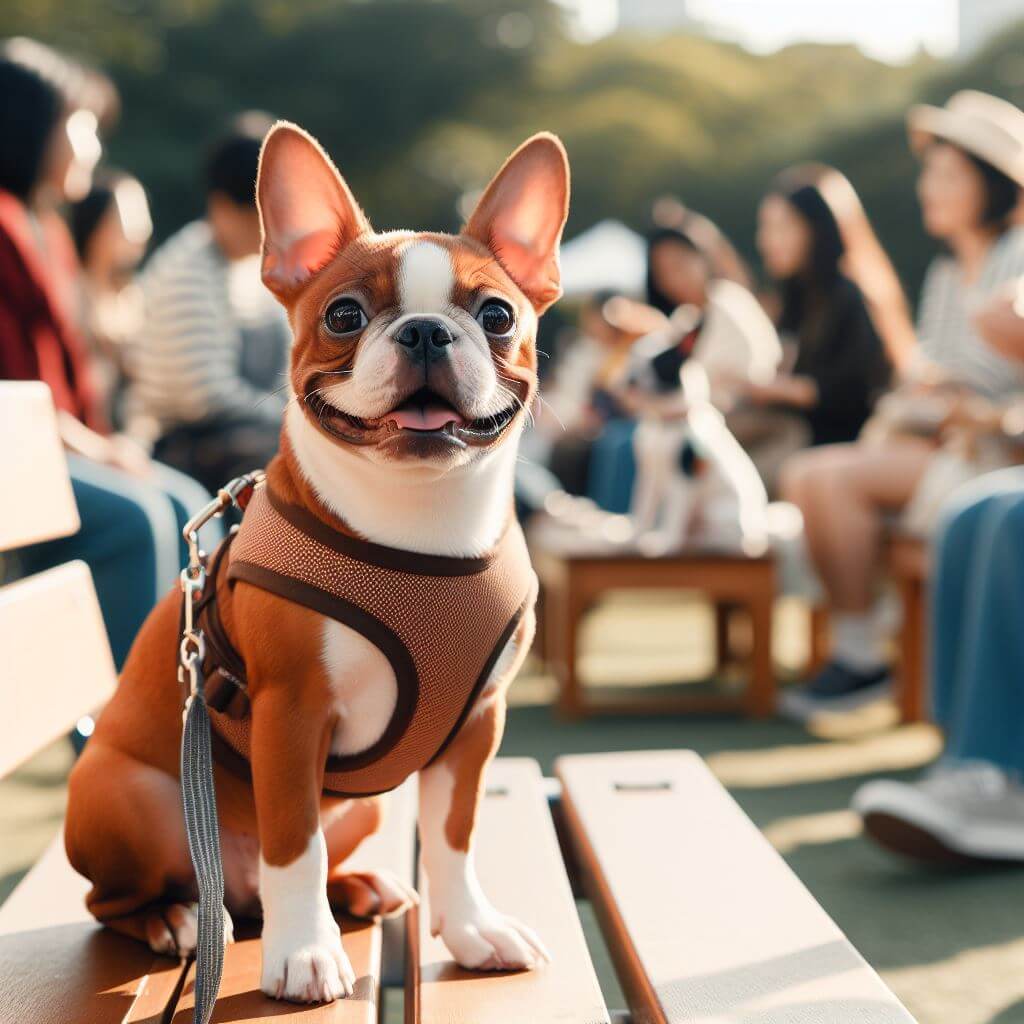
Red Boston Terrier socialize
Start Early
Socializing your Boston Terrier should begin as young as 7 to 8 weeks of age. The sooner you expose your Boston to new situations, the better. These early experiences will help them be less anxious or afraid later o.
Meet New People
Take your puppy on car rides, walks to a park, and to different places to socialize them and get them used to their world without fear or anxiety2. Introduce your puppy to large groups only after having socialized them in small groups.
Interact with Other Animals
Boston Terriers are typically not aggressive towards other dogs if socialized at a young age. They can be stubborn dogs and will always try to outrank you. Be sure to let your Boston know you are the boss. Never allow them to jump up on or chase anyone.
Treats
Reward your dog for displaying good social skills using treats, praise, touch, and even play. Do not reward behaviors that you do not want to be repeated.
Caretaker
As a caretaker, take each step slowly, allowing your Boston to adapt to each scenario. Remember, socializing any dog takes time, patience, and consistency. With all this in mind, socializing your Boston will be a rewarding experience for you and your pet.
Grooming
Regular grooming is essential for the health of your Red Boston Terrier. This includes regular dental care, weekly coat brushing, and monthly bathing1. You should also trim your dog’s nails and clean your dog’s ears regularly.
Diet
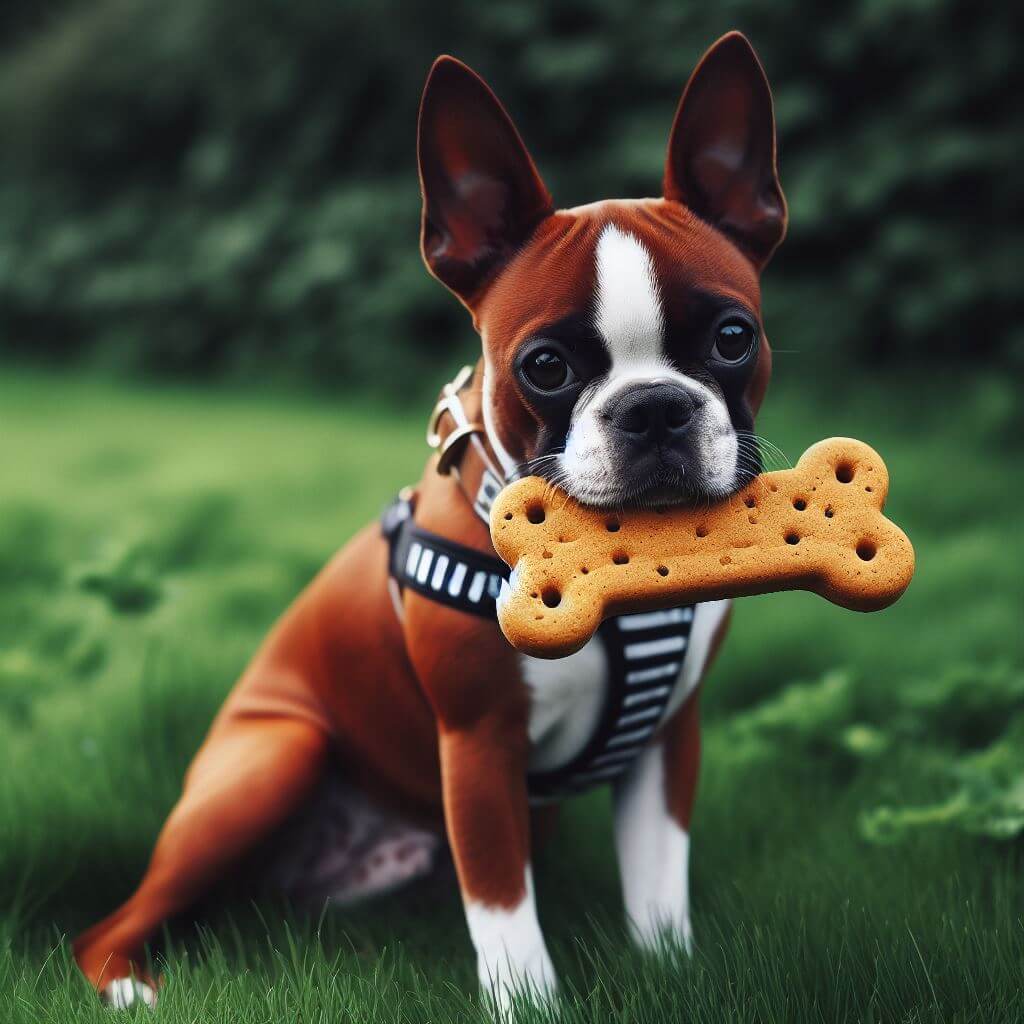
Red boston terrier diet
A Boston Terrier’s diet should consist of biologically appropriate proteins, healthy fats, ground bones, and vegetables, which are packed with essential vitamins and minerals. Avoid excess calories, as Boston Terriers are prone to obesity. Please provide at least 18% protein and 5% fat for adult dogs and more for puppies to support their growth and development.
Living Space
Red Boston Terriers can live anywhere if they are protected from the weather. They are great for apartment living due to their small size and low maintenance.
Rescue and Adoption
There are several organizations dedicated to the rescue and adoption of Boston Terriers. These include the Boston Terrier Rescue, MidAmerica Boston Terrier Rescue6, and Southern Cross Boston Terrier Rescue.
Lifestyle Compatibility
Red Boston Terriers are well-mannered dogs with a cool temperament. They are affectionate, smart, and people-oriented. They are great companions for anyone, regardless of whether they know them or not.
Puppy vs. Adult Dog
Boston Terriers tend to live for around 11–13 years. Their overly playful temperament subsides and they enter full maturity when they are between 12 and 14 months old.
Cost of Ownership
The average cost of a Red Boston Terrier is $989.00. However, the price range for a Red Boston Terrier can vary greatly. The overall lifetime cost of owning a Boston Terrier could be around $12,000-$15,000.
Breeder Research
When purchasing a Boston Terrier online, be sure to find a reputable breeder. Use this article as your guide: How To Find A Reputable Boston Terrier Breeder.
Lifetime Commitment
Owning a Boston Terrier is a lifetime commitment. They tend to live for around 11–13 years, and their longevity will be affected by factors such as health conditions and genetics, lifestyle, exercise, nutrition, and their environment.
Community and Resources
There are several resources available for Red Boston Terrier owners. These include the Boston Terrier Society, Hepper, and Tryfi.
Behavioral Training
Training a Boston Terrier requires patience and consistency. They are intelligent dogs and can be trained easily with positive reinforcement techniques.
Routine and Consistency
Boston Terriers thrive on routine and consistency. Regular feeding times, exercise schedules, and grooming routines can help keep your Boston Terrier healthy and happy.
Travel and Accommodation
Boston Terriers are adaptable and can adjust to different environments. However, due to their brachycephalic nature, they may face difficulties in extreme weather conditions.
Ownership Responsibilities
Owning a Boston Terrier comes with responsibilities such as providing proper nutrition, regular exercise, grooming, and veterinary care. It’s also important to provide mental stimulation for your Boston Terrier to keep them happy and healthy.
Companionship and Loyalty
Boston Terriers are known for their companionship and loyalty. They are affectionate dogs that love spending time with their families. They are also known to be good with children and other pets.
I hope this information helps you understand more about Red Boston Terriers. If you have any other questions, feel free to ask!
What are some common socialization mistakes to avoid the Red Boston Terrier?
Socializing your Red Boston Terrier is an important part of their upbringing. However, there are some common mistakes that you should avoid:
- Starting Late: Socialization should begin when your Boston Terrier is a young puppy. Exposing them to different people, sounds, and situations early will help them overcome their fears.
- Forcing Interaction: If your Boston Terrier is anxious or fearful, don’t force them to socialize. Allow them to take their time and get comfortable with new situations at their own pace.
- Allowing Bad Behavior: Your Boston Terrier should never grab food from you, from the table, or someone’s hand without permission. They should also never chase children, joggers, or other people.
- Playing Tug of War: Avoid playing tug of war with your dog. This game can encourage aggressive behavior and may lead to dominance issues.
- Lack of Supervision: Any dog, no matter how nice, can develop obnoxious levels of barking, digging, and other undesirable behaviors if they are bored, untrained, or unsupervised.
Remember, socializing any dog takes time, patience, and consistency. With all this in mind, socializing your Boston will be a rewarding experience for you and your pet.
How do I know if my Red Boston Terrier is properly socialized?
A well-socialized Red Boston Terrier will exhibit several key behaviors:
- Outgoing and Playful: A well-socialized Boston Terrier is outgoing and playful but never obnoxiously demanding of time and attention.
- Adaptable: They will adapt themselves to your schedule.
- Affectionate and Good with People: They are affectionate and good with people, including children.
- Open to Strangers and New Experiences: They are playful, friendly, and open to strangers and new experiences.
- High-Energy and Alert: They are high-energy and alert.
- Sociable Species with an Active Disposition and Intelligence: Red Boston Terriers are a sociable species with an active disposition and intelligence.
- People-Oriented Breeds: They are people-oriented breeds, so you may take them for a walk and be sure they will be interested in everyone, including people walking past, sitting beside, or moving.
Remember, socialization is an ongoing process and it’s important to continue exposing your dog to new experiences and environments throughout their life. If you notice any changes in your dog’s behavior, it may be a good idea to consult with a professional dog trainer or behaviorist.
How do I socialize my Red Boston Terrier with children?
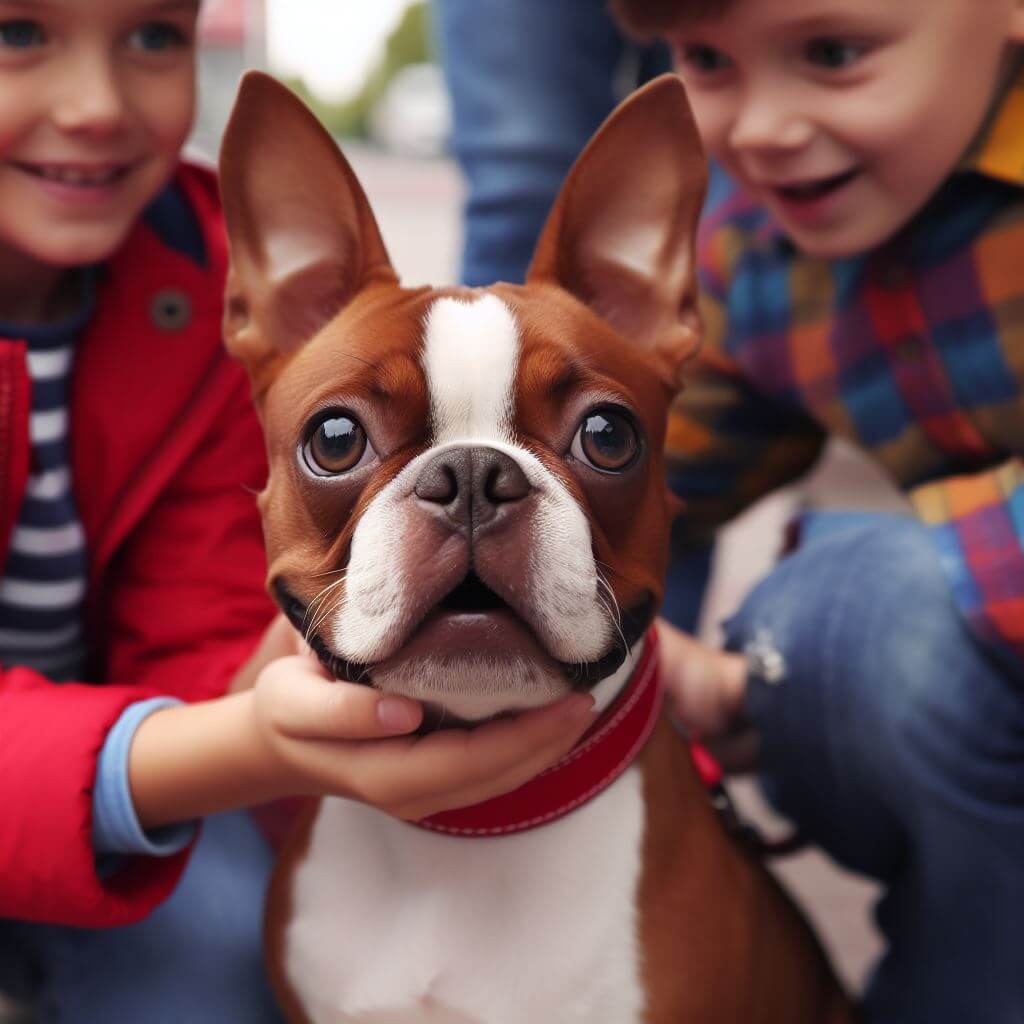
Red boston terrier socialize children
Socializing your Red Boston Terrier with children is an important part of their upbringing. Here are some tips on how to do it:
- Start Early: Socialization should begin when your Boston Terrier is a young puppy. The sooner you expose your Boston to new situations, the better.
- Introduce Regularly: Introduce your dog to your kids regularly. This will help them get used to being around children and reduce any fear or anxiety they may have.
- Use Positive Reinforcement: Use dog treats and positive reinforcements whenever they get along with your kids. This will encourage good behavior and make the socialization process more enjoyable for your dog.
- Train Your Dog: Train your dog not to jump on children. This is important for the safety of both your dog and your children.
- Respect Your Dog’s Feelings: Don’t try to force them to play with your child. Let it happen naturally. If your dog is uncomfortable or scared, give them some space and try again later.
Remember, socializing any dog takes time, patience, and consistency. With all this in mind, socializing your Boston will be a rewarding experience for you and your pet.
Socializing your Red Boston Terrier with other dogs is very important. Here are some steps you can follow:
- Start Early: Socialization should begin when your Boston Terrier is as young as 7 to 8 weeks of age. The sooner you expose your Boston to new situations, the better.
- Introduce Regularly: Introduce your dog to small groups before large groups. This will help them get used to being around other dogs and reduce any fear or anxiety they may have.
- Use Positive Reinforcement: Use dog treats and positive reinforcements whenever they get along with other dogs. This will encourage good behavior and make the socialization process more enjoyable for your dog.
- Train Your Dog: Train your dog not to jump on other dogs. This is important for the safety of both your dog and other dogs.
- Respect Your Dog’s Feelings: Don’t try to force them to play with other dogs. Let it happen naturally. If your dog is uncomfortable or scared, give them some space and try again later.
- Dog Park: The dog park is a great place to let your dog play freely with multiple dogs at one time, under the supervision of the owner.
Remember, socializing any dog takes time, patience, and consistency. With all this in mind, socializing your Boston will be a rewarding experience for you and your pet.
What are some common signs of fear or aggression in a Red Boston Terrier?

Red boston terrier fear
Red Boston Terriers, like other dogs, can exhibit signs of fear or aggression when they feel threatened or uncomfortable. Here are some common signs to look out for:
- Growling or Snarling: One of the most obvious signs of aggressive behavior in dogs is growling or snarling.
- Baring Teeth: Baring teeth is another common sign of aggression in dogs.
- Hackles Up: When a dog’s hackles (the hair on their back) stand up, it’s usually a sign that they are feeling threatened or aggressive.
- Stiff Body Posture: A stiff body posture can be a sign of aggression.
- Lunging or Snapping: Lunging or snapping at people or other animals can be a sign of aggression.
- Non-stop Barking or Howling: Non-stop barking or howling can be a sign of anxiety.
- Urine Dribbling: Urine dribbling can be a sign of fear or anxiety.
- Chewing Everything in Sight: Chewing everything in sight can be a sign of anxiety.
- Exhaling Sharply (Chuffing): Exhaling sharply, also known as chuffing, can be a sign of anxiety.
- Tail Thumping: Tail thumping can be a sign of anxiety.
- Escaping: Trying to escape can be a sign of fear or anxiety.
- Yawning Constantly: Yawning constantly can be a sign of anxiety.
- Shaking and Trembling: Shaking and trembling can be a sign of fear or anxiety.
- Hiding: Hiding can be a sign of fear or anxiety.
- Scratching: Scratching can be a sign of anxiety.
If you notice any of these signs in your Red Boston Terrier, it’s important to consult with a professional dog trainer or behaviorist to address these issues.
How do I train my Red Boston Terrier?
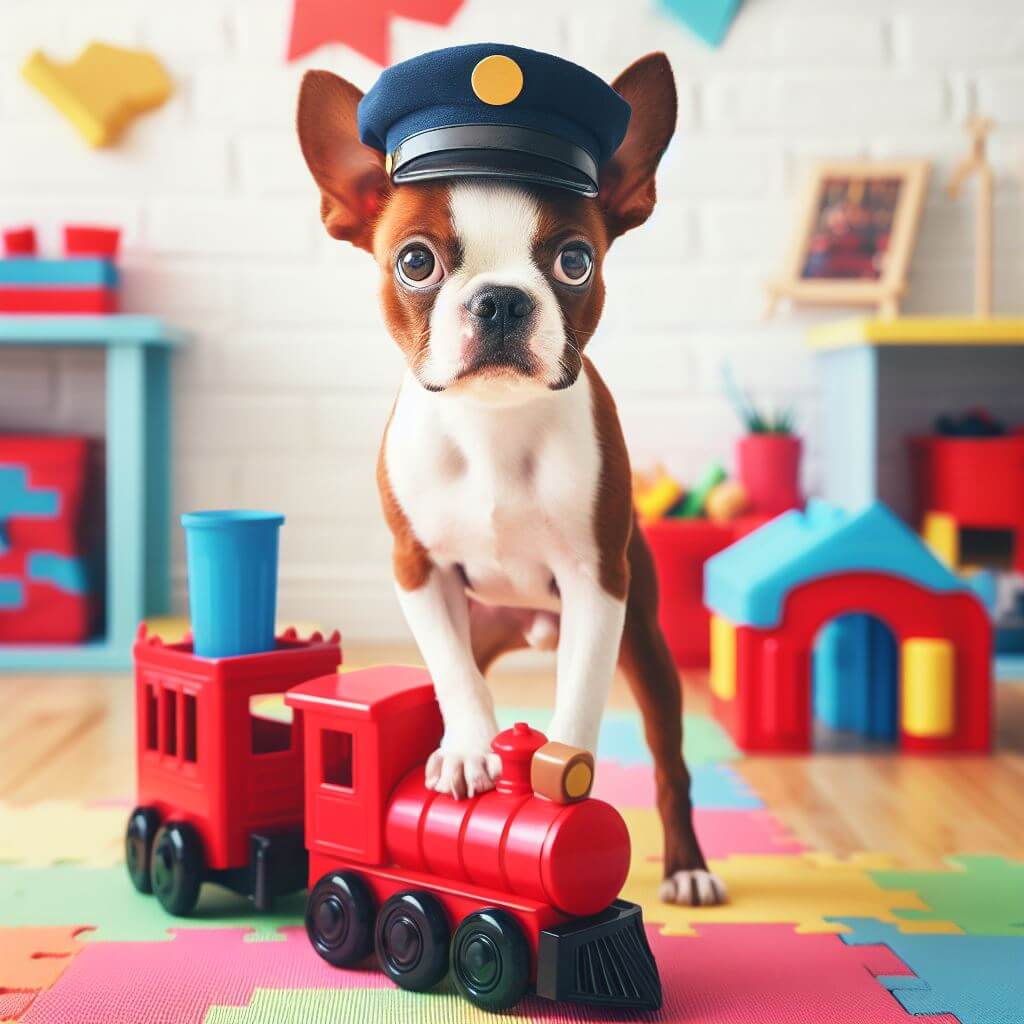
Red boston terrier Training
Training your Red Boston Terrier involves patience, consistency, and positive reinforcement. Here are some steps to help you train your Red Boston Terrier:
- Start Young: Training should begin when your Boston Terrier is a young puppy. The sooner you expose your Boston to new situations, the better.
- Establish a Routine: Bostons, like most dogs, are creatures of habit, and they love having a routine. They will expect their meals at the same time of day, and they will want to be walked at around the same time.
- Use Positive Reinforcement: Positive reinforcement works well with Boston Terriers. This means praising and rewarding them when they perform a desired action. Bostons are known to be food-oriented which makes training easier, especially positive reinforcement.
- Be Patient: To some dogs, training comes naturally. They seem to instinctively know what you want and are happy to listen to your commands whenever you give them. This isn’t true for all dogs, however. Whether your Boston Terrier is a quick learner and a capable student, or it takes longer to pick up even some of the most basic requirements, you need to be patient.
- Socialize: Socialization is an important part of a young dog’s development. Introduce your young Boston Terrier to new people, situations, and animals. This will help ensure that your pup can deal with new situations in the future, and because they are used to being faced with new challenges, it will make elements of training easier, too.
- Train Basic Commands: Start with basic obedience training, such as sit and stay, and advance to more difficult tricks once your pet has mastered all of the basic commands.
Remember, training any dog takes time, patience, and consistency. With all this in mind, training your Boston will be a rewarding experience for you and your pet.
How much exercise does a Red Boston Terrier need?
Red Boston Terriers, like other Boston Terriers, should get at least 30–60 minutes of exercise per day. This can include activities like brisk walks, playtime in a fenced yard, or indoor games, such as fetch or tug-of-war. They are not particularly sedentary like other small dogs. They will require regular walks and playtime. However, because they are smaller, they do not need as much exercise as larger dogs. They can function well in a city as long as you walk them regularly.
What are some common health issues in the Red Boston Terrier?
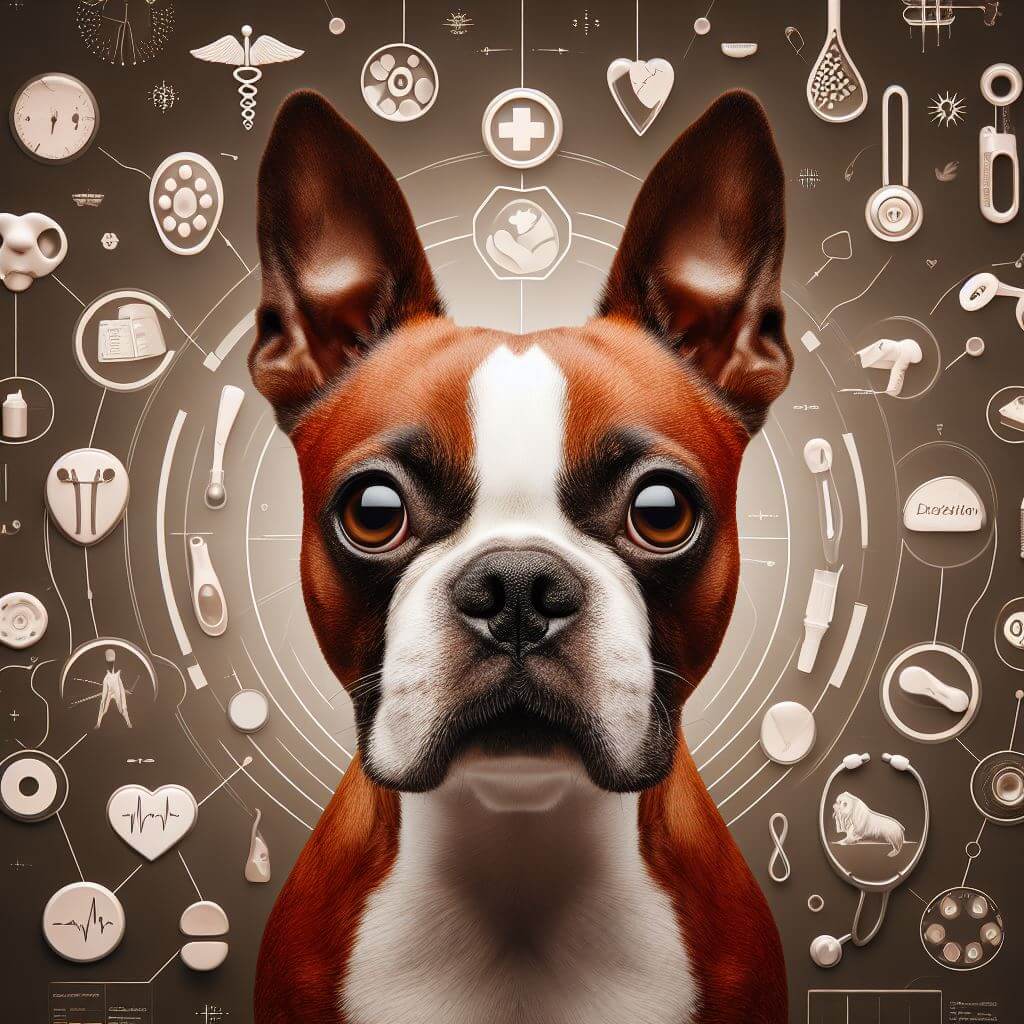
Red boston terrier health issue
Red Boston Terriers, like other Boston Terriers, are prone to certain health conditions. Here are some common health issues that may affect Red Boston Terriers:
- Brachycephalic Syndrome: This is a common issue in breeds with short noses like the Boston Terrier. It includes an elongated soft palate, stenotic nares, and everted laryngeal saccules, which can cause severe breathing difficulty, especially during exercise.
- Patellar Luxation: This is a condition where the dog’s kneecap slides out of its groove, causing an abnormal walk. It’s common in small-breed dogs like the Boston Terrier.
- Hemivertebrae: This is a condition where one or more vertebrae are deformed, causing a twist in the spine.
- Eye Problems: Boston Terriers may develop eye problems such as corneal ulcers.
- Obesity: Obesity can lead to health issues like high blood pressure, diabetes, low thyroid hormone production, urinary tract infection, and possibly even cancer.
- Other Issues: They can also suffer from dental diseases, heart failure, cancer, arthritis, stomach gas, sensorineural deafness, pyloric stenosis, megaesophagus, Cushing’s disease, hydrocephalus, hernias, distichiasis, corneal dystrophy, entropion, and Cherry eye.
Regular veterinary checkups, maintaining a healthy weight with regular exercise, and a proper diet can help prevent or delay some of these problems. If you notice any changes in your dog’s behavior or health, it’s important to consult with a veterinarian.
Indoor and outdoor games for Red Boston Terrier
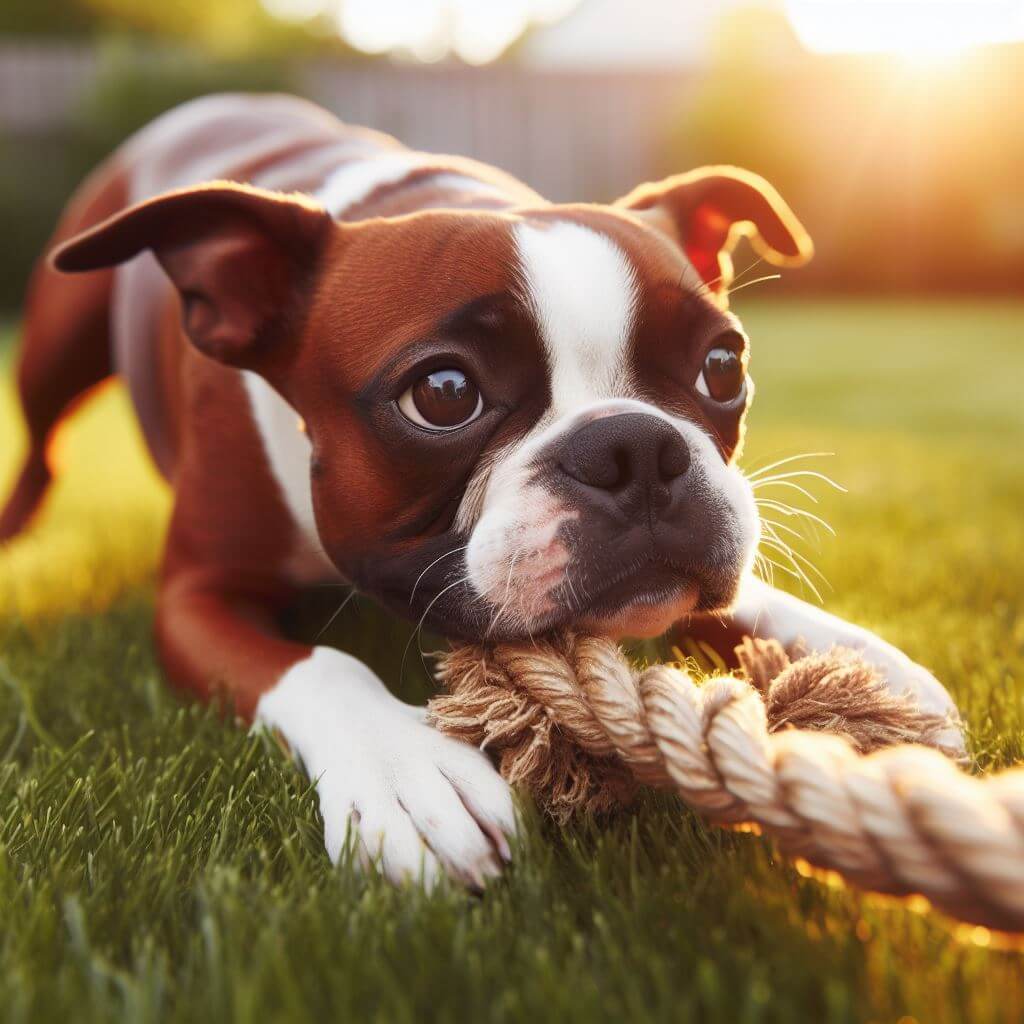
Red boston terrier games
Red Boston Terriers are energetic and playful dogs that love to engage in various activities. Here are some indoor and outdoor games you can play with your Red Boston Terrier:
Indoor Games:
- Fetch: This is a great backyard game, but it can still be played indoors.
- Hide And Seek: Hide treats or your Boston Terrier’s favorite toy, and then have them find it.
- Tug Of War: This game can be played indoors and is a favorite among many dogs.
- Interactive Toys: There are many interactive toys available that can keep your dog entertained indoors.
- Puzzle Games: Puzzle games are a great way to keep your dog mentally stimulated.
- Find the Treat: Hide treats around your house and let your dog sniff out their locations.
- Chase Bubbles: Many dogs love to chase and pop bubbles. Luckily, there are non-toxic, dog-safe bubbles available for pets to play with.
Outdoor Games:
- Fetch Through the Sprinkler: The heat of summer is hard on dogs. Fetch through the sprinkler is a fun way to keep your dog cool while they play.
- Go For a Swim: If your dog loves swimming, there are more and more spots popping up that offer swim time for dogs.
- Play Hide-and-Seek: Hide and Seek is an easy outdoor game that doesn’t require any special equipment.
- Hide Toys and Treats: You can also play hide-and-seek with objects like toys or treats. Hide them all around your yard and let your dog sniff out their locations.
Remember, it’s important to consider your dog’s activity level, overall health, and personality when choosing games to play. Always supervise playtime to ensure your dog’s safety.
How do I groom my Red Boston Terrier?
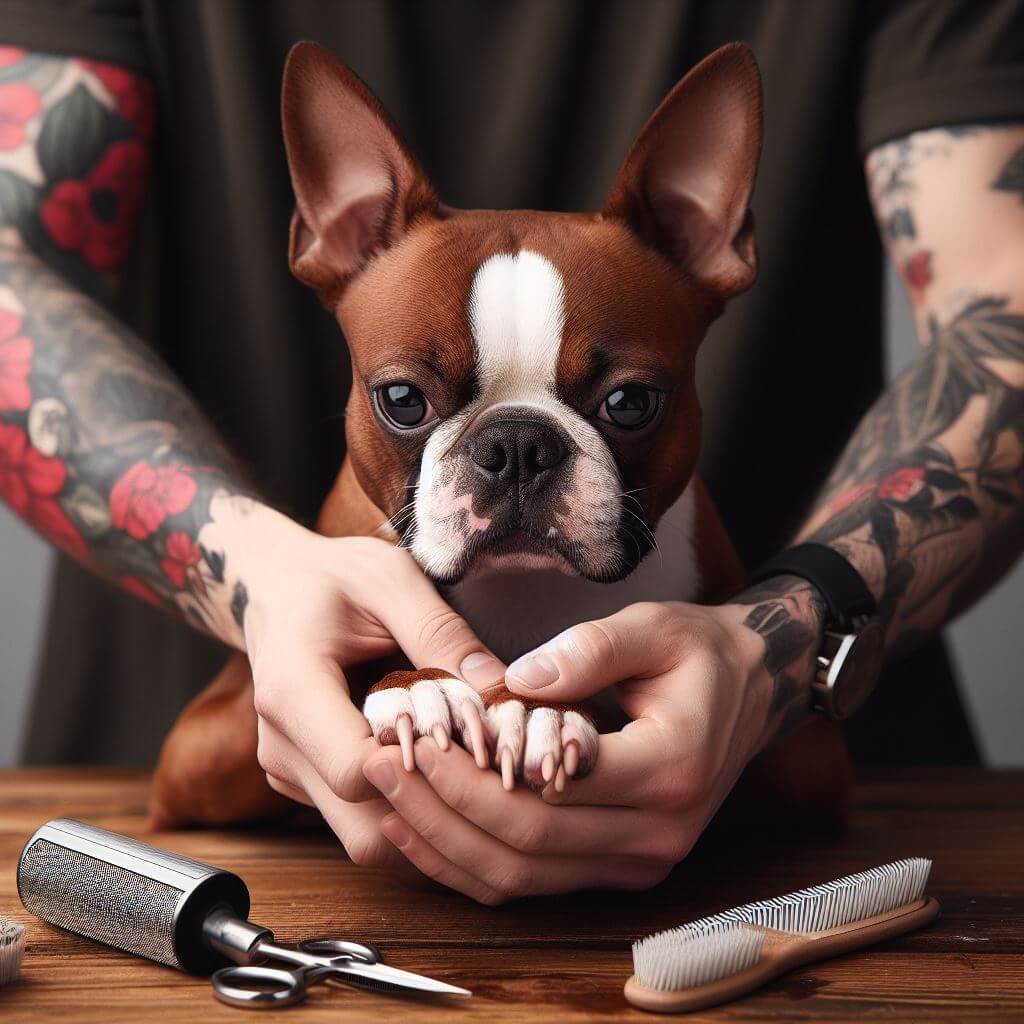
Red boston terrier care and Grooming
Sure, here are a couple of YouTube videos that can guide you on how to groom your Red Boston Terrier:
- Basic Grooming Needs Of A Boston Terrier: This video provides an overview of the basic grooming needs of a Boston Terrier. It covers how often to bathe and brush a Boston Terrier and how often to clean your Boston in general.
- How To Groom Your BOSTON TERRIER: This video discusses the grooming requirements of a Boston Terrier. It’s not an in-depth tutorial, but it gives you a good idea of what to expect when grooming your Boston Terrier.
Remember, regular grooming is essential for the health of your Red Boston Terrier. This includes regular dental care, weekly coat brushing, and monthly bathing. You should also trim your dog’s nails and clean your dog’s ears regularly.
Here are some frequently asked questions about Red Boston Terriers:
- What is a Red Boston Terrier?
A Red Boston Terrier is a Boston Terrier that has red or liver coloring where the black of a standard Boston Terrier would be. They may also have hazel eyes and a red nose. The Red Boston Terrier is a non-standard color and is not recognized by most kennel clubs or breed clubs, but it is not considered a rare variant. - What does a Red Boston Terrier look like?
Red Boston Terriers are compactly built, standing 15 to 17 inches in height and weighing 12 to 25 pounds. They belong to a family of brachycephalic dogs, which are breeds with shortened snouts. Their coat has a varying shade of copper red to vivid red. According to Cypress Farms Kennel, this shouldn’t include any black hair or pigmentation. White markings are present in the chest, between the eyes, and around the muzzle. - What is the temperament of a Red Boston Terrier?
Red Boston Terriers are more than just puppy eyes and formal tuxedo attire; they are fond of human interactions, too. That being said, they make a great companion for anyone. The red Boston Terrier may be unique to its kind, but it is still confused with the similarly-looking French Bulldog and Boxer. - Are Red Boston Terriers rare?
Non-reputable breeders make a lot of money claiming that this color is rare. However, it is not. Several studies have long investigated the early existence of red Boston dogs. - What are some common health issues in Red Boston Terriers?
Red Boston Terriers are prone to several health issues. Some of the common health issues are Brachycephalic Airway Syndrome, Patellar Luxation, Hemivertebrae, Corneal Ulceration, Cherry Eye, Entropion, Cataracts, Glaucoma, Deafness, and Digestive issues such as diarrhea or bleeding.

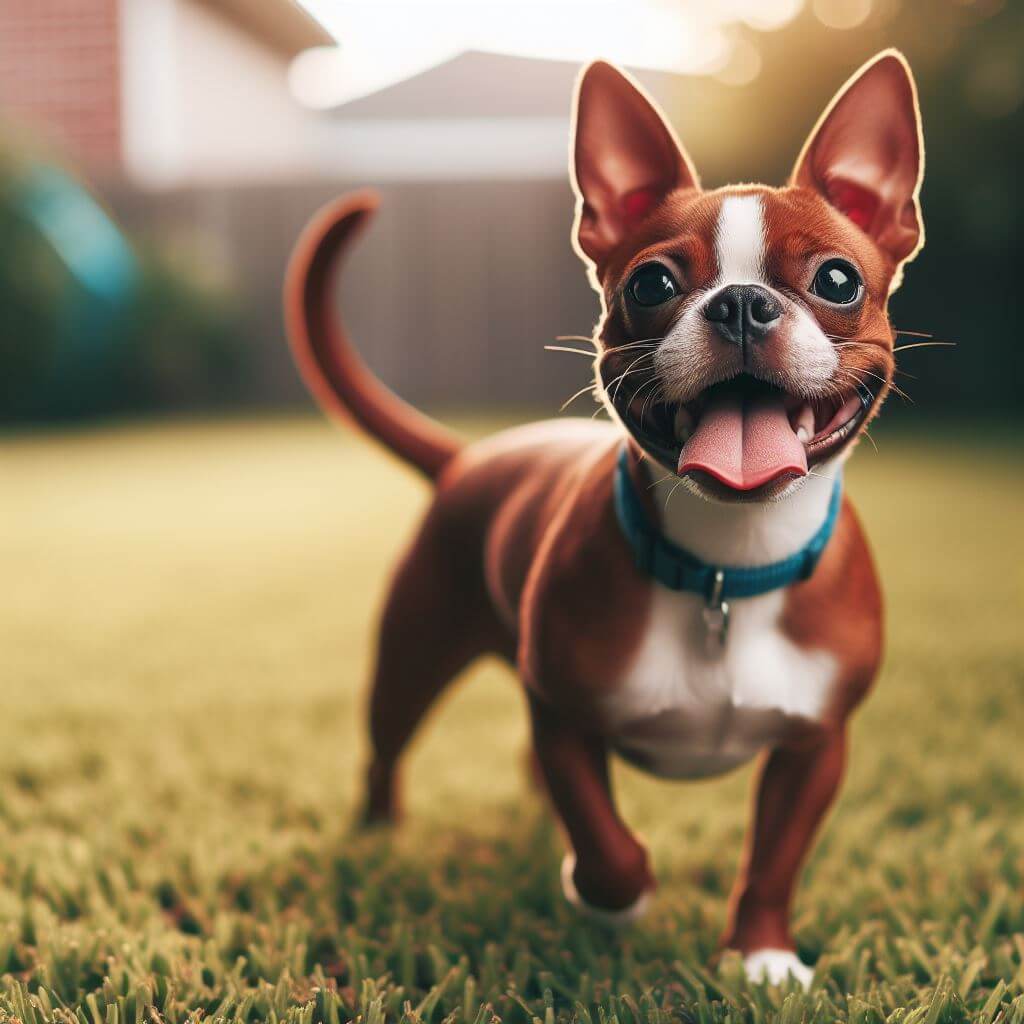
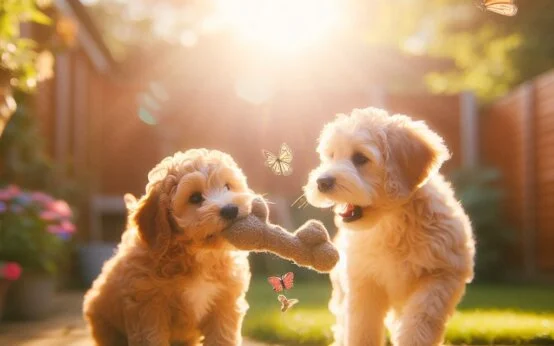 Mini Labradoodle: A Complete Guide
Mini Labradoodle: A Complete Guide 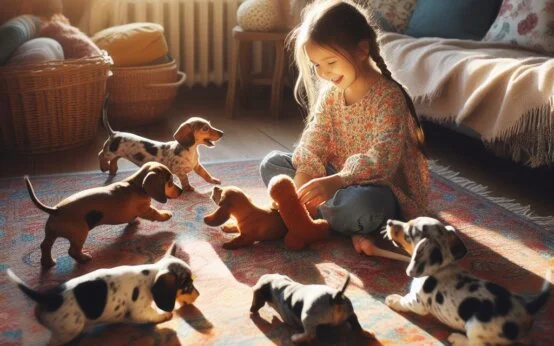 Dapple Dachshund: A Unique and Lively Breed
Dapple Dachshund: A Unique and Lively Breed 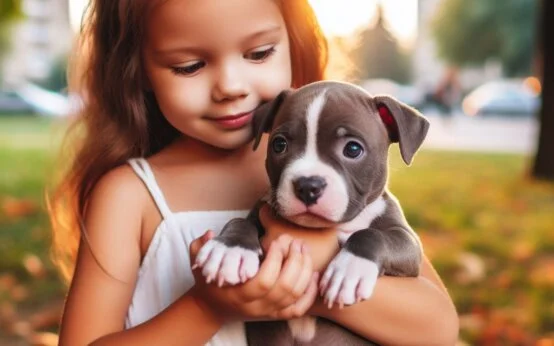 Pocket Pitbull: A Compact Canine Companion
Pocket Pitbull: A Compact Canine Companion 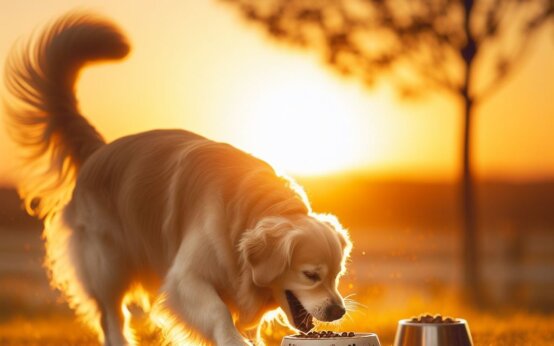 Preparing for an Adventure: A Golden Retriever Packs Its Suitcase
Preparing for an Adventure: A Golden Retriever Packs Its Suitcase 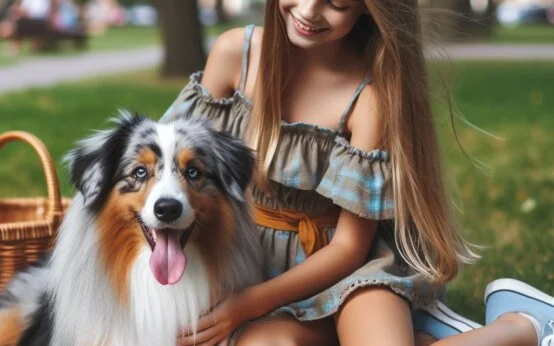 The Blue Merle Australian Shepherd: A Captivating and Unique Breed
The Blue Merle Australian Shepherd: A Captivating and Unique Breed 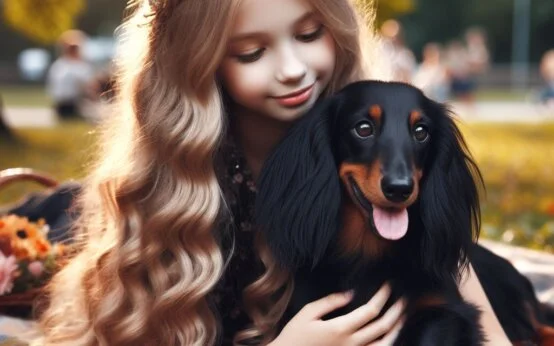 Long Haired Dachshund: A Guide to This Charming Breed
Long Haired Dachshund: A Guide to This Charming Breed 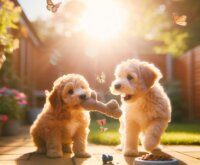 Mini Labradoodle: A Complete Guide
Mini Labradoodle: A Complete Guide 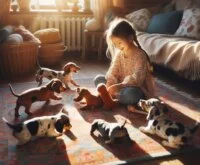 Dapple Dachshund: A Unique and Lively Breed
Dapple Dachshund: A Unique and Lively Breed  Pocket Pitbull: A Compact Canine Companion
Pocket Pitbull: A Compact Canine Companion 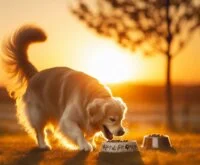 Preparing for an Adventure: A Golden Retriever Packs Its Suitcase
Preparing for an Adventure: A Golden Retriever Packs Its Suitcase 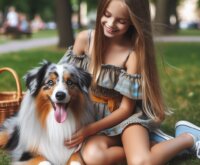 The Blue Merle Australian Shepherd: A Captivating and Unique Breed
The Blue Merle Australian Shepherd: A Captivating and Unique Breed 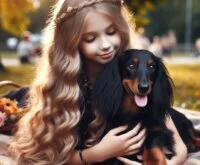 Long Haired Dachshund: A Guide to This Charming Breed
Long Haired Dachshund: A Guide to This Charming Breed
nswp53
iwbruw